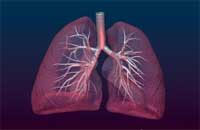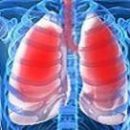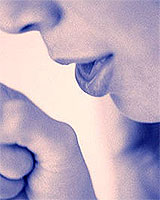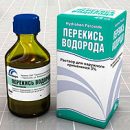Purriter is inflammation of the pleura with the formation of a fibrinous plaque on its surface or effusion in its cavity. In the emergence of pleurisites of infectious etiology, the leading role belongs to specific and nonspecific pathogens. By the nature of inflammation, pleurites are divided into dry and outstanding.
Content
Purritont - inflammation of the pleura with the formation of fibrinous plaque on its surface or effusion in its cavity. It is always secondary, is a syndrome or complication of many diseases, but during a certain period can be moved in a clinical picture to the fore, masking the main disease.
Mechanisms for the development of the disease
 The emergence of pleurisites of infectious nature is due to the impact of pathogens of specific (mycobacterium tuberculosis, pale treponema) and nonspecific (pneumococci, staphylococci, intestinal wand, viruses, mushrooms, etc.) infections; The pathogens penetrate the pleura contact path, lymphogenically, hematogenically, with violation of the cavity of the pleura. Frequently caused by the development of pleurite are systemic diseases of the connective tissue (rheumatism, systemic red lupus and others.); neoplasm; thromboembolism and thrombosis of pulmonary arteries. Pathogenesis of most pleurite allergic. In the development of blastomatous pleuritis, the tumor metastases of lymph nodes, lymphatic and venous vessels, during germination of the adjacent organs - the destruction of serous covers.
The emergence of pleurisites of infectious nature is due to the impact of pathogens of specific (mycobacterium tuberculosis, pale treponema) and nonspecific (pneumococci, staphylococci, intestinal wand, viruses, mushrooms, etc.) infections; The pathogens penetrate the pleura contact path, lymphogenically, hematogenically, with violation of the cavity of the pleura. Frequently caused by the development of pleurite are systemic diseases of the connective tissue (rheumatism, systemic red lupus and others.); neoplasm; thromboembolism and thrombosis of pulmonary arteries. Pathogenesis of most pleurite allergic. In the development of blastomatous pleuritis, the tumor metastases of lymph nodes, lymphatic and venous vessels, during germination of the adjacent organs - the destruction of serous covers.
Symptoms, the flow is determined by localization, prevalence, character of inflammation of the pleura, change in the function of neighboring organs. Main forms of pleurisites: Dry, or fibrinous, discharge, or exudative. Exudative pleurisites, in turn, are separated by the nature of shipping for serous, serous-fibrinous, purulent, hemorrhagic, mixed. Having determined the nature of reach, you can clarify the reason for the development of pleuritis and choose pathogenetic therapy. So, the reason for the occurrence of dry and serous, serous-fibrinous pleurites is more often tuberculosis, pneumonia, rheumatism and other systemic diseases of connective tissue (rheumatic, lupus and other pleurisites). Hemorrhagic plerites are most often developing with neoplasms, thromboembolis and thrombosis of pulmonary vessels, hemorrhagic diatenes, flu, less often with tuberculosis, rheumatism. The location of payments distinguish:
- Parakostal
- diaphragmal
- paramediastinals
- Interdoles
Dry Plegritis
Dry, or fibrinous, pleurisy. The main symptom - pain in the side, amplifying when inhaling, cough. Pain sensations decrease in the position on the affected side. Restriction of the respiratory mobility of the corresponding half of the chest. Body temperature is more often subfebrile, there may be chills, night sweat, weakness. Difficult diagnosis of diaphragmal dry pleurisites. They are characterized by pain in the chest, in the hypochondrium, in the region of the lower ribs, the idol, pain in the abdomen, flatulence, the tension of the abdominal muscles, pain when swallowing. Type of breast breathing with only the top of the chest and the enhancement of pain in its lower part with deep breath. Pour pain points:
- In the first intercostal intervals of the sternum
- At the point of attaching a diaphragm to ribs
- On the coolest process of the first cervical vertebra
In the recognition of the diaphragmal pleurisites, a x-ray study helps, in which the indirect symptoms of functional disorders of the diaphragm are detected: its high standing, limiting its mobility on the sore side. The beneficial duration of the disease is 10-14 days, but there are relapses of dry pleuritis for several weeks with subsequent recovery.
Exudative Plegritis
Paying, or exudative, pleurisy. At the beginning of the pleural exudation, pain in side, restriction of the respiratory mobility of the affected side of the chest, the noise of friction of the pleura. Often there is a dry painful cough of reflex nature. As the accumulation of accumulation of pain in the side disappears, there are sensations of gravity, increasing shortness of breath, moderate cyanosis, some escape of the affected side, smoothing intercostal intervals. At percussion and x-ray examination, the characteristic contour of the upper limit of traffic may be determined. Large effusion causes the mediastum displacement into a healthy side and significant violations of the function of external respiration due to the violation of respiratory mechanics: the depth of breathing is reduced, it is expensive; The methods of functional diagnostics reveals a decrease in external respiration (lung life capacity, ventilation reserves, etc.). There are violations of the cardiovascular system, which are manifested by a decrease in the shock and minute volume of the heart due to a decrease in blood sinking into central veins due to ventilation disorders, displacement of the heart and large vessels at large pleural efflores; Development compensatory tachycardia. Hell tends to reduce.
For exudative pleuritic, especially infectious nature, characterized by febrile body temperature from the very beginning of pleural exudation, expressed symptoms of intoxication, leukocytosis,. Pleural exudate has a relative density above 1016-1018, rich in cellular elements, gives a positive reaction of rivals. Purritite tumor etiology excludes cytological examination of exudate. Depends on the etiology of pleurite. With infectious-allergic plerites, including tuberculosis, exudate can resolve for 2-4 weeks. There is an outcome with the development of the pleural cavity of the adhesive process in the pleural cavity, the infection of pleural cavities and interdetal cracks, the formation of massive overlaps, the moor, the rusters of the pleura, the formation of respiratory failure.









